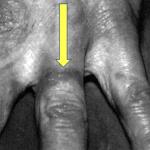Gold is an atomic snob. It has nothing but disdain for almost all chemicals that might want to bond with it. With few exceptions, gold – a noble metal (1) – is quite pleased with itself; it doesn't want to change.
gold
OK, that title is a bit overblown, but it's also correct. Sort of. Although incredibly rare, decades ago a small number of people had their fingers chopped off because they were wearing wedding rings.
Here is what the average American knows about gold:
Though they are both metals, gold and uranium have little in common.
Besides making wigs, or perhaps some rather bizarre clothing and artwork, there aren't a lot of practical uses for discarded human hair.







